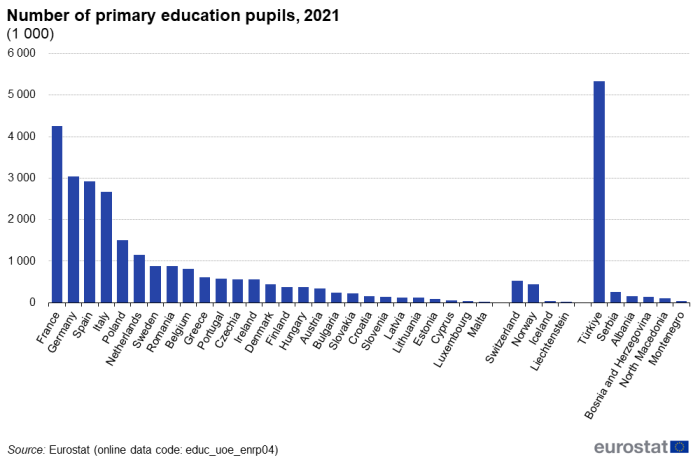Primary education statistics
Data extracted in July 2023.
Planned article update: September 2024.
Highlights
In 2021, there were 23.2 million primary school pupils and 1.89 million primary school teachers across the EU.
86 % of primary school teachers in the EU in 2021 were women. 20 % of primary school teachers in the EU were younger than 35 years, 43 % were aged 35 to 49 years and 36 % were aged 50 years and over.
In 2021, there were, on average, 13.4 pupils per teacher in primary education across the EU, ranging from an average of 8.0 in Greece to 18.7 in Romania.
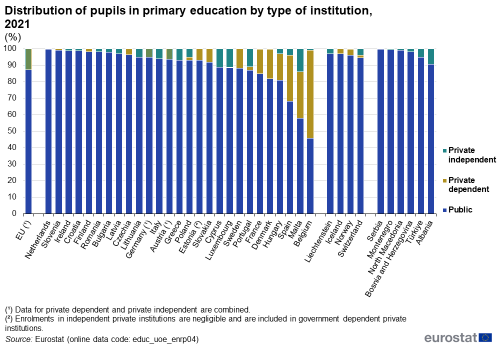
(%)
Source: Eurostat (educ_uoe_enrp04)
This article presents statistics on primary education (ISCED level 1) in the European Union (EU) and forms part of an online publication on education and training in the EU.
School helps young people acquire basic life skills and competences that are necessary for their personal development. The quality of a pupil's early school experience affects not only their development, but also their future place in society, level of educational attainment and employment opportunities. Primary education may be the first experience pupils have of school and prepares them for the secondary level of their education.
The quality of education may be linked to teaching standards, which in turn are related to the demands placed upon teachers, the training they receive, the roles they are asked to fill and the resources that are made available for them to carry out their tasks. Equally, the quality of education may show local or regional variations, related to a variety of socio-demographic factors.
Full article
Participation
In the EU, there were 23.2 million pupils in primary education in 2021. The number of pupils found in primary education in each of the EU Member States reflects their population size, demographic structure, as well as differences in the typical age for starting primary education and the age at which children should start their compulsory formal education.
The largest number of primary education pupils in 2021 among the EU Member States was 4.3 million in France. This was notably larger than in Germany, Spain and Italy, which had 3.0 million, 2.9 million and 2.7 million, respectively.
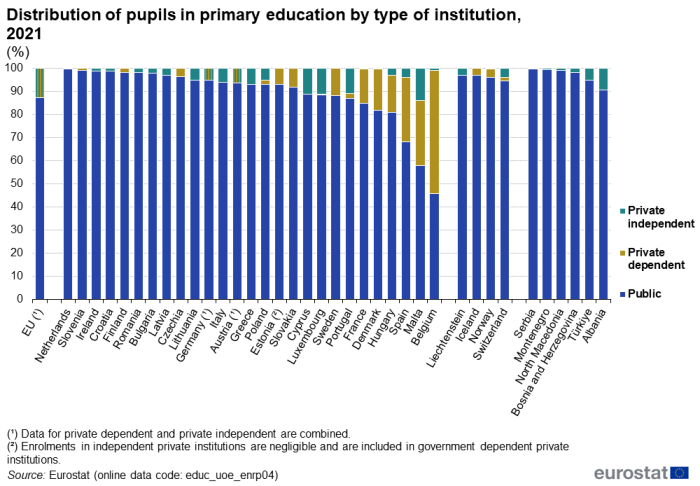
(%)
Source: Eurostat (educ_uoe_enrp04)
Across the EU as a whole, 87.3 % of primary education pupils in 2021 were in public institutions, with the remainder in private institutions [1]. The split between public and private institutions was heavily skewed among the EU Member States, as 20 of the 27 had a share of primary pupils in public institutions that was above the average for the EU. The seven with shares of primary pupils in private institutions below the EU average were Portugal, France, Denmark, Hungary, Spain, Malta and Belgium. Belgium was the only Member State where a majority of primary pupils were in private education. In six of the seven EU Member States with higher-than-average shares of primary pupils in private institutions, private dependent institutions had a larger – often much larger – share of primary pupils than did private independent institutions; the one exception was Portugal.
A majority (53.3 %) of primary pupils in Belgium were educated in private dependent institutions, with the next highest shares in this type of institution recorded in Malta (28.2 %) and Spain (27.9 %); four other Member States – Hungary, Denmark, France and Sweden – recorded shares above 10.0 %. The highest share of primary pupils in private independent institutions was 13.8 % in Malta, with Cyprus, Luxembourg and Portugal the only other Member States with shares above 10.0 %.
Number of teachers and pupil–teacher ratios
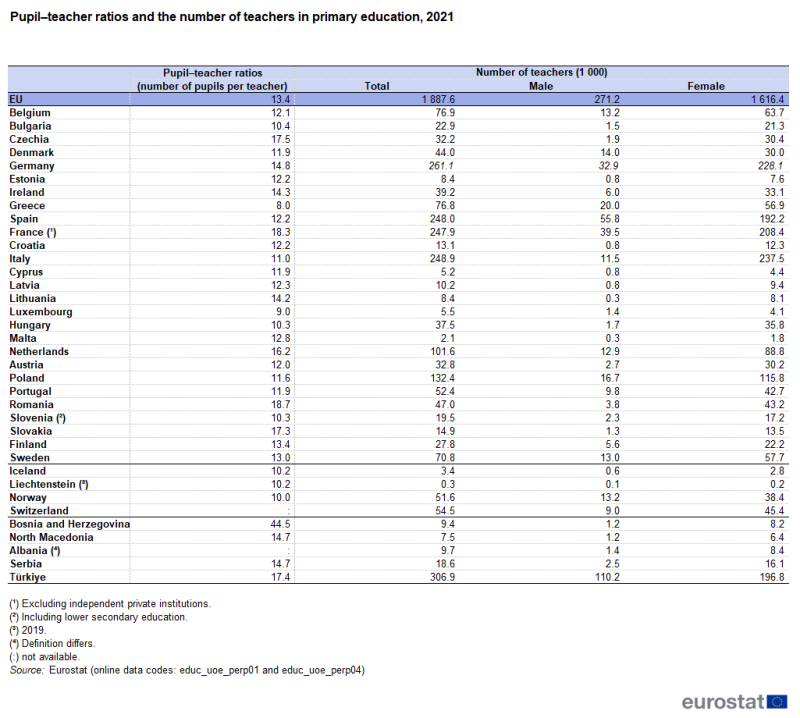
Source: Eurostat (educ_uoe_perp01) and (educ_uoe_perp04)
One measure which may be used indirectly to analyse the quality of schooling is the pupil–teacher ratio. This provides an indication of the average number of pupils there are for each teacher (see Table 1). In 2021, the average for the EU was 13.4 primary education pupils per teacher.
In 2021, the lowest pupil–teacher ratios for primary education were recorded in Greece and Luxembourg, with ratios of 8.0 and 9.0 pupils per teacher, respectively; these were the only EU Member States to report single-digit ratios (below 10.0). At the other end of the range, pupil–teacher ratios above 15.0 primary education pupils per teacher were reported in the Netherlands, Slovakia, Czechia and France (excluding independent private institutions), with Romania recording the highest ratio, 18.7 pupils per teacher.
There were 1.89 million primary education teachers in the EU in 2021; note that the figures exclude teachers in independent private institutions for France and include lower secondary education teachers for Slovenia. The largest number of primary education teachers in 2021 among the EU Member States was (to the nearest thousand) 261 000 in Germany. This was slightly more than in Italy (249 000), Spain (248 000) and France (also 248 000, incomplete).
Sex and age of teachers
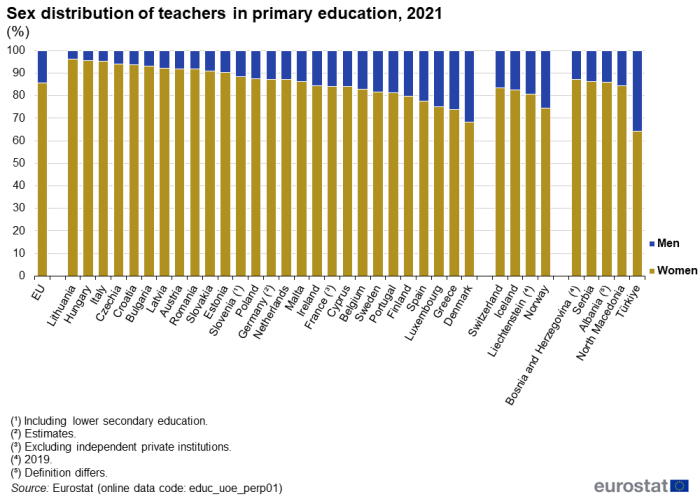
(%)
Source: Eurostat (educ_uoe_perp01)
In primary education, there is a clear dominance of female over male teachers in the EU. There were 271 000 male teachers in 2021 in primary education compared with 1.6 million female teachers.
The share of female primary education teachers averaged 85.6 % across the EU in 2021, with male teachers accounting for 14.4 %. The share of male teachers was below 10.0 % in 11 EU Member States, below 20.0 % in 22 Member States, and below one-third in all of the Member States. The lowest share of male primary education teachers in 2021 was 3.7 % in Lithuania. The highest share of male primary education teachers was in Denmark, at 31.7 %.
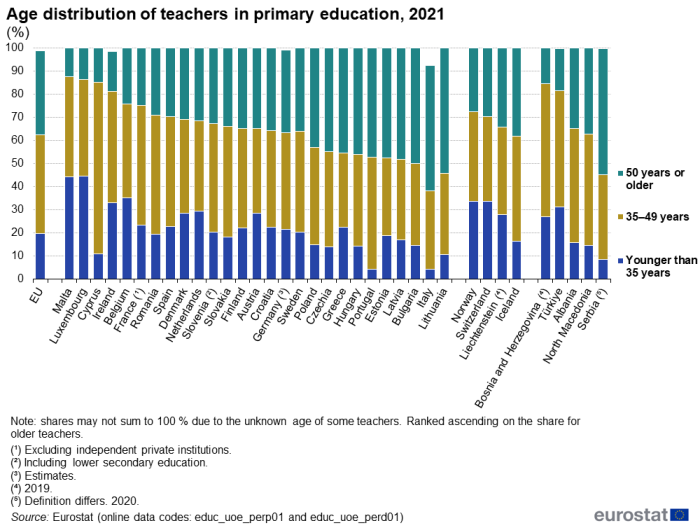
(%)
Source: Eurostat (educ_uoe_perp01) and (educ_uoe_perd01)
In 2021, around one-fifth (19.7 %) of primary education teachers in the EU were younger than 35 years of age. The largest age cohort was for teachers aged 35–49 years with a 42.8 % share, followed by older teachers (those aged 50 years and over) with a share of 36.3 %. Note that the shares for these three age classes do not sum to 100.0 % for the EU due to the age of some teachers (mainly in Germany and Italy) being unknown. For comparison, in 2021 persons under the age of 35 years made up 28.2 % of all employed persons, persons aged 35–49 years made up 37.6 % and persons aged over 50 years made up 34.1 %.
The share of older primary education teachers was above 20.0 % in 23 EU Member States and above 30.0 % in 19 of these. The highest shares of older primary education teachers were observed in Lithuania and Italy, both of which reported that a majority of teachers at this education level were aged 50 years and over; in Bulgaria, 50.0 % were aged 50 years and over. The four Member States with shares for older teachers that were below 20.0 % were Ireland, Cyprus, Luxembourg and Malta. Malta and Luxembourg recorded particularly high shares of younger primary education teachers, more than double the EU average.
Source data for tables and graphs
Data sources
Source
The standards for international statistics on education are set by three international organisations:
- the United Nations Educational, Scientific, and Cultural Organisation (UNESCO) institute for statistics (UIS);
- the Organisation for Economic Co-operation and Development (OECD);
- Eurostat, the statistical office of the EU.
The source of data used in this article is a joint UNESCO/OECD/Eurostat (UOE) data collection on education statistics and this is the basis for the core components of Eurostat's database on education statistics; in combination with the joint data collection Eurostat also collects data on regional enrolments and foreign language learning.
More information about the joint data collection is available in an article on the UOE methodology.
Classification
The international standard classification of education (ISCED) is the basis for international education statistics, describing nine different levels of education.
Key concepts
Pupil–teacher ratios are calculated by dividing the number of full-time equivalent pupils and students in each level of education by the number of full-time equivalent teachers at the same level. This ratio should not be confused with average class size, which refers to the number of students in a given course or classroom.
Context
Age is generally the sole criterion for admission to compulsory primary education. This starts in most of the EU Member States when children reach 6 years of age. Bulgaria, Estonia, Croatia and Finland have a compulsory starting age for primary education of 7 years, while Malta (5 years) has a younger starting age. Although education is compulsory at 5 or 6 years of age in Latvia, Lithuania, Poland and Sweden, this is at early childhood education level, not primary education which starts at 7 years. More information about the starting age of compulsory primary education is provided in national quality reports (national metadata) attached to the metadata for administrative data on education. Note that in close to half of the Member States it is also compulsory for young children to attend pre-primary education (usually at 5 years of age).
Among EU Member States, primary education typically lasts 6 years, although its duration can range between 4 and 7 years; as a result, it typically lasts until a child is 10–12 years. Primary education programmes are typically designed to provide students with fundamental skills in reading, writing and mathematics (in other words literacy and numeracy) and to establish a solid foundation for learning and understanding core areas of knowledge, personal and social development, in preparation for lower secondary education. It focuses on learning at a basic level of complexity with little, if any, specialisation.
Direct access to
Notes
- ↑ According to the UOE classification, the distinction between public and private is made according to whether a public agency or a private entity has the overall control of the institution and not according to which sector provides the majority of the funding. If a private institution receives the majority of funding from a public agency it is considered to be dependent; if not it is independent.
- Participation in education and training (educ_part)
- Education personnel (educ_uoe_per)
Metadata
- Pupils and students - enrolments (ESMS metadata file – educ_uoe_enr_esms)
Manuals and other methodological information
- International Standard Classification of Education (ISCED) 2011
- ISCED 2011 Operational Manual – Guidelines for classifying national education programmes and related qualifications
- UOE data collection on formal education – Manual on concepts, definitions and classifications – 2022 edition
- UNESCO OECD Eurostat (UOE) joint data collection – methodology
- Regulation (EC) No 452/2008 of 23 April 2008 concerning the production and development of statistics on education and lifelong learning
- Commission Regulation (EU) No 912/2013 of 23 September 2013 as regards statistics on education and training systems
- Summaries of EU Legislation: statistics on education and lifelong learning
